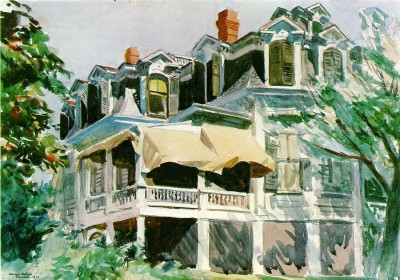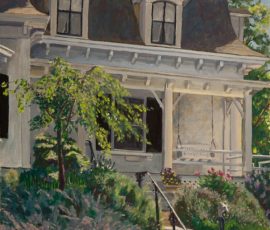While looking at certain works of representational art, do you ever wonder what the scene or subject matter really looked like before the artist translated it to canvas? Here’s a great example using artist Edward Hopper. According to Julie Bosman of the New York Times, “Photographer Gail Albert Halaban has been locating the original houses in Edward Hopper’s paintings and taking pictures of them as they look today.”
Then:
and now:
Julie Bosman continues, “Greta Bagshaw, whose husband’s family has owned the ‘‘Mansard Roof ’’ since 1962, is accustomed to attention. ‘‘Not infrequently we’ve seen people who set up easels in our backyard (in Gloucester, Mass.) to paint it,’’ Bagshaw says. ‘‘We know it’s time to put up the awnings each year when we’re eating on the porch and we turn around and see a big tour group watching us eat dinner.’’
Then:
and now:
Of course to New Yorkers, Edward Hopper is likely to evoke visions of moody nighttime urban scenes. But the painter created some of his most famous work in the bright seaside town of Gloucester, Mass., on Cape Ann, where he spent time in the 1920s.
Then:
and now:
According to the National Gallery of Art, “Both commonplace and mysterious, [Hopper’s] haunting images led many to praise him as the most American of painters. That’s because, if you ask me, an artist’s eye is filled with magic.
Related articles
- Long Before ‘Nighthawks,’ a Boy Loved the Hudson (nytimes.com)
- A Matter of Rust (zatista.com)
- Hearing Colors (zatista.com)










Comments (0)